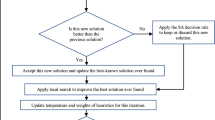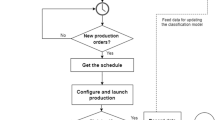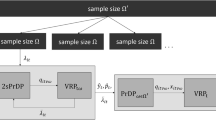Abstract
The two stage assembly flowshop scheduling problem has a lot of applications, and hence, it has recently received more attention in the scheduling literature. The performance measure of total tardiness is important as the fulfillment of due dates of customers has to be taken into account while making scheduling decisions. To the best of our knowledge, the problem with this performance measure has not been addressed so far, and hence, it is addressed in this paper. Different algorithms are proposed for the problem. The proposed algorithms are; an insertion algorithm, a genetic algorithm, two versions of simulated annealing algorithm (SA), and two versions of cloud theory-based SA. Moreover, the proposed insertion algorithm (PIA) is combined with the rest of the algorithms resulting in a total of eleven algorithms. Computational analysis, by using a non-parametric statistical test, indicates that one of the versions of the SA combined with the PIA performs better than the rest of the algorithms. The PIA helps in reducing the error of the SA by about seventy percent. It is worth to state that the performance of the combined algorithm is neither possible to achieve by the insertion algorithm alone nor by the simulated annealing alone no matter how much more computational time is given to the each.







Similar content being viewed by others
References
Al-Anzi, F. S., & Allahverdi, A. (2007). A self-adaptive differential evolution heuristic for two-stage assembly scheduling problem to minimize maximum lateness with setup times. European Journal of Operational Research, 182, 80–94.
Al-Anzi, F. S., & Allahverdi, A. (2006). A hybrid tabu search heuristic for the two-stage assembly scheduling problem. International Journal of Operations Research, 3, 109–119.
Allahverdi, A., Ng, C. T., Cheng, T. C. E., & Kovalyov, M. Y. (2008). A survey of scheduling problems with setup times or costs. European Journal of Operational Research, 187, 985–1032.
Allahverdi, A., Gupta, J. N. D., & Aldowaisan, T. (1999). A review of scheduling research involving setup considerations. OMEGA The International Journal of Management Sciences, 27, 219–239.
Allahverdi, A., & Al-Anzi, F. S. (2009). The two-stage assembly scheduling problem to minimize total completion time with setup times. Computers and Operations Research, 36, 2740–2747.
Allahverdi, A., & Al-Anzi, F. S. (2008). The two-stage assembly flowshop scheduling problem with bicriteria of makespan and mean completion time. International Journal of Advanced Manufacturing Technology, 37, 166–177.
Allahverdi, A., & Al-Anzi, F. S. (2006a). Evolutionary heuristics and an algorithm for the two-stage assembly scheduling problem to minimize makespan with setup times. International Journal of Production Research, 44, 4713–4735.
Allahverdi, A., & Al-Anzi, F. S. (2006b). APSO and a Tabu search heuristics for assembly scheduling problem of the two-stage distributed database application. Computers and Operations Research, 33, 1056–1080.
Allahverdi, A., & Soroush, H. M. (2008). The significance of reducing setup times/setup costs. European Journal of Operational Research, 187, 978–984.
Aydilek, H., & Allahverdi, A. (2012). Heuristics for no-wait flowshops with makespan subject to mean completion time. Applied Mathematics and Computation, 219, 351–359.
Bean, J. (1994). Genetics and random keys for sequencing and optimization. ORSA Journal on Computing, 6, 154–160.
Chen, J. C., Wu, C. C., Chen, C. W., & Chen, K. H. (2012). Flexible job shop scheduling with parallel machines using Genetic Algorithm and Grouping Genetic Algorithm. Expert Systems with Applications, 39, 10016–10021.
Du, J., & Leung, J. (1990). Minimizing total tardiness on one machine is NP-hard. Operations Research, 38, 22–36.
El Amraoui, A., Manier, M. A., El Moudni, A., & Benrejeb, M. (2012). Resolution of the two-part cyclic hoist scheduling problem with bounded processing times in complex lines’ configuration. European Journal of Industrial Engineering, 6, 454–473.
Framinan, J. M., & Leisten, R. (2008). Total tardiness minimization in permutation flow shops: a simple approach based on a variable greedy algorithm. International Journal of Production Research, 46, 6479–6498.
Hall, N. G., & Posner, M. E. (2001). Generating experimental data for computational testing with machine scheduling applications. Operations Research, 49, 854–865.
Hariri, A. M. A., & Potts, C. N. (1997). A branch and bound algorithm for the two-stage assembly scheduling problem. European Journal of Operational Research, 103, 547–556.
Haouari, M., & Daouas, T. (1999). Optimal scheduling of the 3-machine assembly-type flow shop. RAIRO Recherche Operationnelle, 33, 439–445.
Huang, J., Suer, G. A., & Urs, S. B. R. (2012). Genetic algorithm for rotary machine scheduling with dependent processing times. Journal of Intelligent Manufacturing, 23, 1931–1948.
Kim, Y. D. (1993). A new branch and bound algorithm for minimizing mean tardiness in two-machine flowshops. Computers and Operations Research, 20, 391–401.
Ladhari, T., Msakni, M. K., & Allahverdi, A. (2012). Minimizing the total completion time in a two-machine flowshop with sequence-independent setup times. Journal of the Operational Research Society, 63, 445–459.
Lee, C. Y., Cheng, T. C. E., & Lin, B. M. T. (1993). Minimizing the makespan in the 3-machine assembly-type flowshop scheduling problem. Management Science, 39, 616–625.
Lin, S. W., & Ying, K. C. (2012). Scheduling a bi-criteria flowshop manufacturing cell with sequence-dependent family setup times. European Journal of Industrial Engineering, 6, 474–496.
Mirsanei, H. S., Zandieh, M., Moayed, M. J., & Khabbazi, M. R. (2011). A simulated annealing algorithm approach to hybrid flow shop scheduling with sequence-dependent setup times. Journal of Intelligent Manufacturing, 22, 965–978.
Naderi, B., & Salmasi, N. (2012). Permutation flowshops in group scheduling with sequence-dependent setup times. European Journal of Industrial Engineering, 6, 177–198.
Onwubolu, G., & Mutingi, M. (1999). Genetic algorithm for minimizing tardiness in flow-shop scheduling. Production Planning & Control, 10, 462–471.
Poppenborg, J., Knust, S., & Hertzberg, J. (2012). Online scheduling of flexible job-shops with blocking and transportation. European Journal of Industrial Engineering, 6, 497–518.
Potts, C. N., Sevast’janov, S. V., Strusevich, V. A., Van Wassenhove, L. N., & Zwaneveld, C. M. (1995). The two-stage assembly scheduling problem: complexity and approximation. Operations Research, 43, 346–355.
Ruiz, R., Maroto, C., & Alcaraz, J. (2006). Two new robust genetic algorithms for the flowshop scheduling problem. OMEGA The International Journal of Management Science, 34, 461–476.
Sauvey, C., & Sauer, N. (2012). A genetic algorithm with genes-association recognition for flowshop scheduling problems. Journal of Intelligent Manufacturing, 23, 1167–1177.
Shokrollahpour, E., Zandieh, M., & Dorri, B. (2011). A novel imperialist competitive algorithm for bi-criteria scheduling of the assembly flowshop problem. International Journal of Production Research, 49, 3087–3103.
Solano-Charris, E. L., Montoya-Torres, J. R., & Paternina-Arboleda, C. D. (2011). Ant colony optimization algorithm for a Bi-criteria 2-stage hybrid flowshop scheduling problem. Journal of Intelligent Manufacturing, 22, 815–822.
Soroush, H. M. (2012). Solving the single machine scheduling problem with general job-dependent past-sequence-dependent setup times and learning effects. European Journal of Industrial Engineering, 6, 596–628.
Sun, X., Morizawa, K., & Nagasawa, H. (2003). Powerful heuristics to minimize makespan in fixed, 3-machine, assembly-type flowshop scheduling. European Journal of Operational Research, 146, 498–516.
Tajbakhsh, A., Eshghi, K., & Shamsi, A. (2012). A hybrid PSO-SA algorithm for the travelling tournament problem. European Journal of Industrial Engineering, 6, 2–25.
Torabzadeh, E., & Zandieh, M. (2010). Cloud theory-based simulated annealing approach for scheduling in the two-stage assembly flowshop. Advances in Engineering Software, 41, 1238–1243.
Tozkapan, A., Kirca, O., & Chung, C. S. (2003). A branch and bound algorithm to minimize the total weighted flowtime for the two-stage assembly scheduling problem. Computers and Operations Research, 30, 309–320.
Vallada, E., & Ruiz, R. (2010). Genetic algorithms with path relinking for the minimum tardiness permutation flowshop problem. OMEGA International Journal of Management Science, 38, 57–67.
Vallada, E., Ruiz, R., & Minella, G. (2008). Minimizing total tardiness in the m-machine flowshop problem: A review and evaluation of heuristics and metaheuristics. Computers and Operations Research, 35, 1350–1373.
Ventura, J. A., & Yoon, S. H. (2013). A new genetic algorithm for lot-streaming flow shop scheduling with limited capacity buffers. Journal of Intelligent Manufacturing. doi:10.1007/s10845-012-0650-9.
Vinod, V., & Sridharan, R. (2009). Simulation-based metamodels for scheduling a dynamic job shop with sequence-dependent setup times. International Journal of Production Research, 47, 1425–1447.
Ying, K. C. (2012). Minimising makespan for multistage hybrid flowshop scheduling problems with multiprocessor tasks by a hybrid immune algorithm. European Journal of Industrial Engineering, 6, 199–215.
Ying, K. C., Lee, Z. J., & Lin, S. W. (2012). Makespan minimization for scheduling unrelated parallel machines with setup times. Journal of Intelligent Manufacturing, 23, 1795–1803.
Acknowledgments
The authors are indebted to two anonymous referees for their excellent and valuable comments which improved the quality of the proposed algorithms significantly. This research was supported by Kuwait University Research Administration Grant No. EI03/09. The research was conducted when Ali Allahverdi was a visiting professor at the Department of Industrial and Systems Engineering, Rensselaer Polytechnic Institute, Troy, New York, USA.
Author information
Authors and Affiliations
Corresponding author
Rights and permissions
About this article
Cite this article
Allahverdi, A., Aydilek, H. The two stage assembly flowshop scheduling problem to minimize total tardiness. J Intell Manuf 26, 225–237 (2015). https://doi.org/10.1007/s10845-013-0775-5
Received:
Accepted:
Published:
Issue Date:
DOI: https://doi.org/10.1007/s10845-013-0775-5




